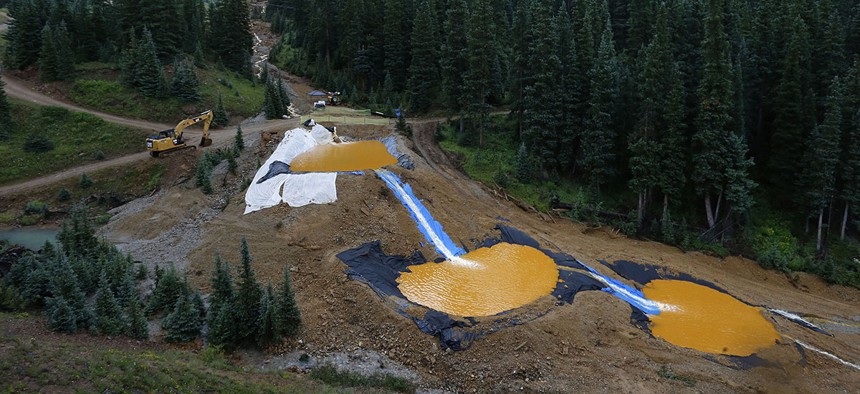Interior Department Report Faults EPA In Colorado Mine Spill
Agency warns that the circumstances around the mine spill are “surprisingly prevalent.”
A federal probe has found that the Environmental Protection Agency could have done more to prevent a spill of waste from an abandoned mine that polluted two Colorado rivers in August.
The Interior Department on Thursday released a report on the incident, in which an EPA team triggered a blowout at the Gold King Mine that turned nearby water a sickly orange color. The report from the DOI’s Bureau of Reclamation says that the EPA team in charge of the mine cleanup did not understand the complexity of the site and take the necessary precautions.
But the department also cautions that the conditions that led to the blowout at the Gold King Mine are “surprisingly prevalent” and that there are insufficient federal guidelines for reopening abandoned mines, even as the government works to clean up tens of thousands of such sites across the West.
Specifically, the report says that EPA did not adequately evaluate the buildup of fluid in the mine and the groundwater conditions around it. At a previous cleanup at a different site, the report said, officials drilled into the mine from above to determine the level of water, but federal and state officials elected not to do so at the Gold King Mine.
“Had it been done, the plan to open the mine would have been revised and the blowout would not have occurred,” the report states.
The August spill sent more than 3 million gallons of wastewater loaded with lead, arsenic, mercury, and other metals into the Animas River and the connecting San Juan River, leaving them polluted for days and shutting down commerce along the two rivers.
EPA has taken responsibility for the spill, but in an August assessment said that the spill was “likely inevitable.” That same report said that the work crew thought the water pressure was lower than it was, leading to the approach that caused the blowout.
In a statement Thursday, EPA spokesman Nancy Grantham said the agency “will carefully review the report.”
“This report, in combination with the findings of EPA’s internal review of the incident, will help inform EPA’s ongoing efforts to work safely and effectively at mine sites as we carry out our mission to protect human health and the environment,” Grantham said.
In the aftermath of the spill, Republican critics pounced on EPA, charging that the agency had not been transparent about the cause of the spill and was not subjecting itself to the same scrutiny it would give to a private company behind an environmental disaster.
Predictably, Thursday’s report offered the same opening for the agency’s critics in Congress. House Science Committee chairman Lamar Smith of Texas said that EPA’s “negligence is inexcusable” and that it was “appalling that for months the EPA failed to be forthcoming about what went wrong.”
Senate Environment and Public Works Chairman Jim Inhofe said that the report “raises significant new questions” about the spill and questioned the authority of the Bureau of Reclamation in writing the report. Several committees, including the House Natural Resources Committee, have promised more extensive follow-up on the spill.
But a key finding from the Interior Department report cautions that the circumstances around the Gold King Mine—which had been inoperable since 1923—“are not isolated or unique” and exist at many other mines across the West. Thousands of unregulated mines from earlier in the century were left unaddressed and without regulation, and many are now leaking sludge polluted with toxic metals into water and soil.
The U.S. Geological Survey has identified more than 260,000 abandoned mines, and the environmental groupEarthworks has estimated the number to be as high as a half-million.
EPA was going into the Gold King site because a collapse had stopped up a mine portal, meaning water was building up. In fact, the Interior Report found that at the Gold King site, “even if no action had been taken, it may have failed on its own.”
The EPA and state officials in the West are working through a backlog of such sites, trying to avoid the leaks and a similar blowout. But the Interior Department report cautions that better guidance will be needed as the necessary cleanups continue.
The incident, while preventable, is “somewhat emblematic of the current state of practice in abandoned-mine remediation.”
The report states that federal guidelines for mine cleanups are inconsistent across agencies and that there are few written requirements for reopening the mines. Those that exist have “little appreciation for the engineering complexity of some abandoned mine projects that often require, but do not receive, a significant level of expertise.”



